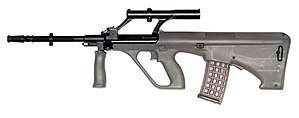Assault rifle
An assault rifle is a selective-fire rifle that uses an intermediate cartridge and a detachable magazine.[1][2][3][4][5] Assault rifles were first put into mass production and accepted into widespread service during World War II.[6][7][8] Though Western nations were slow to accept the assault rifle concept, by the end of the 20th century they had become the standard weapon in most of the world's armies, replacing full-powered rifles and sub-machine guns in most roles.[8] Examples include the StG 44, AK-47 and the M16 rifle.[8]
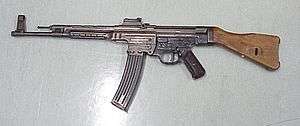
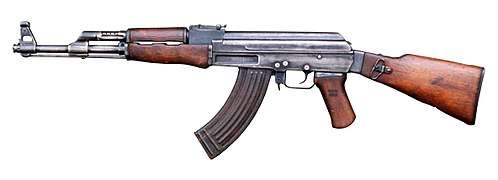

Origin of term
The term assault rifle is generally attributed to Adolf Hitler, who, for propaganda purposes, used the German word Sturmgewehr (which translates to "assault rifle") as the new name for the MP43, subsequently known as the Sturmgewehr 44 or StG 44.[6][8][9][10][11][12][13][14] However, other sources dispute that Hitler had much to do with coining the new name besides signing the production order.[15] The StG 44 is generally considered the first selective fire military rifle to popularize the assault rifle concept.[6][8] Today, the term assault rifle is used to define firearms sharing the same basic characteristics as the StG 44.[6][8]
Characteristics
The U.S. Army defines assault rifles as "short, compact, selective-fire weapons that fire a cartridge intermediate in power between submachine gun and rifle cartridges."[16] In this strict definition, a firearm must have at least the following characteristics to be considered an assault rifle:[2][3][4]
- It must be capable of selective fire.
- It must have an intermediate-power cartridge: more power than a pistol but less than a standard rifle or battle rifle, such as the 7.92×33mm Kurz, the 7.62x39mm and the 5.56×45mm NATO.
- Its ammunition must be supplied from a detachable box magazine.[5]
- It must have an effective range of at least 300 metres (330 yards).
Rifles that meet most of these criteria, but not all, are technically not assault rifles.
For example:
- Select-fire M2 Carbines are not assault rifles; their effective range is only 180 metres (200 yd).[17]
- Select-fire rifles such as the FN FAL battle rifle are not assault rifles; they fire full-powered rifle cartridges.
- Semi-automatic-only rifles like the Colt AR-15 are not assault rifles; they do not have select-fire capabilities.
- Semi-automatic-only rifles with fixed magazines like the SKS are not assault rifles; they do not have detachable box magazines and are not capable of automatic fire.
History
Sturmgewehr 44
The Germans were the first to pioneer the assault rifle concept, during World War II, based upon research that showed that most firefights happen within 400 metres (1,300 ft) and that contemporary rifles were over-powered for most small arms combat.[7][8][9][18][19][20] They would soon develop a select-fire intermediate powered rifle combining the firepower of a submachine gun with the range and accuracy of a rifle.[7][8][9][18][19][20]
The result was the Sturmgewehr 44, which the Germans produced in large numbers; approximately half a million were made.[7][8][9][19][20] It fired a new and revolutionary intermediate powered cartridge, the 7.92×33mm Kurz.[6][7][8][9][19][20][21] This new cartridge was developed by shortening the standard 7.92×57mm Mauser round and giving it a lighter 125-grain bullet, that limited range but allowed for more controllable automatic fire.[6][7][8][9][19][20][21] A smaller lighter cartridge also allowed soldiers to carry more ammunition "to support the higher consumption rate of automatic fire."[8][18]
The Sturmgewehr 44 features an inexpensive, easy-to-make, stamped steel design and a 30-round detachable box magazine.[22] "This weapon was the prototype of all successful automatic rifles. Characteristically (and unlike previous rifles and the M-14) it had a straight stock with the barrel under the gas cylinder to reduce the turning moment of recoil of the rifle in the shoulder and thus help reduce the tendency of shots to climb in automatic fire. The barrel and overall length were shorter than a traditional rifle and it had a pistol grip to hold the weapon more securely in automatic fire. “The principle of this weapon—the reduction of muzzle impulse to get usable automatic fire within the actual ranges of combat—was probably the most important advance in small arms since the invention of smokeless powder."[21]
AK-47
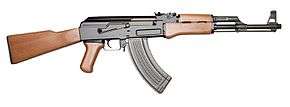
Like the Germans, the Soviets were influenced by experience showing that most combat engagements occur within 400 metres (1,300 ft) and that their soldiers were consistently outgunned by heavily armed German troops, especially those armed with the Sturmgewehr 44 assault rifles.[23][24][25][26][27][28] On July 15, 1943, a Sturmgewehr was demonstrated before the People's Commissariat of Arms of the USSR.[29] The Soviets were so impressed with the Sturmgewehr, that they immediately set about developing an intermediate caliber automatic rifle of their own, to replace the badly outdated Mosin–Nagant bolt-action rifles and PPSh-41 submachine guns that armed most of the Soviet Army.[8][26][28][29][30][31]
The Soviets soon developed the 7.62×39mm M43 cartridge, the semi-automatic SKS carbine and the RPD light machine gun.[32] Shortly after World War II, the Soviets developed the AK-47 assault rifle, which would quickly replace the SKS in Soviet service.[33][34] The AK-47 was finalized, adopted and entered widespread service in the Soviet army in the early 1950s.[23] Its firepower, ease of use, low production costs, and reliability were perfectly suited for the Red Army's new mobile warfare doctrines.[23] In the 1960s, the Soviets introduced the RPK light machine gun, itself an AK-47 type weapon with a bi-pod, a stronger receiver, and a longer, heavier barrel that would eventually replace the RPD light machine gun.[32]
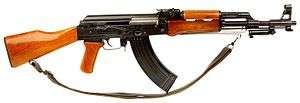
The AK-47 was widely supplied or sold to nations allied with the USSR, and the blueprints were shared with several friendly nations (the People's Republic of China standing out among these with the Type 56).[23] As a result, more AK-type weapons have been produced than all other assault rifles combined.[35] As of 2004, "of the estimated 500 million firearms worldwide, approximately 100 million belong to the Kalashnikov family, three-quarters of which are AK-47s."[35]
Battle rifles
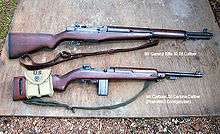
The U.S. Army was influenced by combat experience with semi-automatic weapons such as the M1 Garand and M1 Carbine, which enjoyed a significant advantage over enemies armed primarily with bolt-action rifles.[18] Although U.S. Army studies of World War II combat accounts had very similar results to that of the Germans and Soviets, the U.S. Army failed to recognize the importance of the assault rifle concept,[18] and instead maintained its traditional views and preference for high-powered semi-automatic rifles.[8][18][20][36] At the time, the U.S. Army believed that the Sturmgewehr 44 was "intended in a general way to serve the same purpose as the U.S. carbine" and was in many ways inferior to the M1 carbine,[37] and was of "little importance".[18]
After World War II, the United States military started looking for a single automatic rifle to replace the M1 Garand, M1/M2 Carbines, M1918 Browning Automatic Rifle, M3 "Grease Gun" and Thompson submachine gun.[20][38] Early experiments with select-fire versions of the M1 Garand proved disappointing.[39] During the Korean War, the select-fire M2 Carbine largely replaced the submachine gun in US service[40] and became the most widely used Carbine variant.[41] Combat experience suggested that the .30 Carbine round was under-powered.[42] American weapons designers reached the same conclusion as the German and Soviet ones: an intermediate round was necessary, and recommended a small-caliber, high-velocity cartridge.[8][43]
_(7414626342).jpg)
Senior American commanders had faced fanatical enemies and experienced major logistical problems during WWII and the Korean War,[44][45][46][47] and insisted that a single powerful .30 caliber cartridge be developed, that could be used by the new automatic rifle, and also by the new general-purpose machine gun (GPMG) in concurrent development.[8][48][49] This culminated in the development of the 7.62×51mm NATO cartridge and the M14 rifle[8][48] which was basically an improved select-fire M1 Garand with a 20-round magazine.[50][51][52] The U.S. also adopted the M60 GPMG.[48] Its NATO partners adopted the FN FAL and Heckler & Koch G3 rifles, as well as the FN MAG and Rheinmetall MG3 GPMGs.

The FN FAL is a 7.62×51mm NATO, selective fire, automatic rifle produced by the Belgian armaments manufacturer Fabrique Nationale de Herstal (FN). During the Cold War it was adopted by many North Atlantic Treaty Organization (NATO) countries, most notably with the British Commonwealth as the L1A1. It is one of the most widely used rifles in history, having been used by more than 90 countries.[53] The FAL was predominantly chambered for the 7.62mm NATO round, and because of its prevalence and widespread use among the armed forces of many western nations during the Cold War it was nicknamed "The right arm of the Free World".[54]

The Heckler & Koch G3 is a 7.62×51mm NATO, selective fire, automatic rifle produced by the German armament manufacturer Heckler & Koch GmbH (H&K) in collaboration with the Spanish state-owned design and development agency CETME (Centro de Estudios Técnicos de Materiales Especiales).[55] The rifle proved successful in the export market, being adopted by the armed forces of over 60 countries.[56] After WWII, German technicians involved in developing the Sturmgewehr 45, continued their research in France at CEAM. The StG45 mechanism was modified by Ludwig Vorgrimler and Theodor Löffler at the Mulhouse facility between 1946 and 1949. Vorgrimler later went to work at CETME in Spain and developed the line of CETME automatic rifles based on his improved Stg45 design. Germany eventually purchased the license for the CETME design and manufactured the Heckler & Koch G3 as well as an entire line of weapons built on the same system, one of the most famous being the MP5 SMG.
M16
The first confrontations between the AK-47 and the M14 (assault rifle vs battle rifle) came in the early part of the Vietnam War. Battlefield reports indicated that the M14 was uncontrollable in full-auto and that soldiers could not carry enough ammunition to maintain fire superiority over the AK-47.[8][50][57] And, while the M2 Carbine offered a high rate of fire, it was under-powered and ultimately outclassed by the AK-47.[58] A replacement was needed: A medium between the traditional preference for high-powered rifles such as the M14, and the lightweight firepower of the M2 Carbine.
As a result, the Army was forced to reconsider a 1957 request by General Willard G. Wyman, commander of the U.S. Continental Army Command (CONARC) to develop a .223 caliber (5.56 mm) select-fire rifle weighing 2.7 kg (6 lb) when loaded with a 20-round magazine.[20] The 5.56 mm round had to penetrate a standard U.S. helmet at 460 metres (500 yd) and retain a velocity in excess of the speed of sound, while matching or exceeding the wounding ability of the .30 Carbine cartridge.[59]
This request ultimately resulted in the development of a scaled-down version of the ArmaLite AR-10, called ArmaLite AR-15 rifle.[8][60][61][62] However, despite overwhelming evidence that the AR-15 could bring more firepower to bear than the M14, the Army opposed the adoption of the new rifle.[8][50][60] In January 1963, Secretary of Defense Robert McNamara concluded that the AR-15 was the superior weapon system and ordered a halt to M14 production.[50][60][63] At the time, the AR-15 was the only rifle available that could fulfill the requirement of a universal infantry weapon for issue to all services.
After modifications (most notably, the charging handle was re-located from under the carrying handle like AR-10 to the rear of the receiver),[61] the new redesigned rifle was subsequently adopted as the M16 Rifle.[8][50][60][64] "(The M16) was much lighter compared to the M14 it replaced, ultimately allowing soldiers to carry more ammunition. The air-cooled, gas-operated, magazine-fed assault rifle was made of steel, aluminum alloy and composite plastics, truly cutting-edge for the time. Designed with full and semi-automatic capabilities, the weapon initially did not respond well to wet and dirty conditions, sometimes even jamming in combat. After a few minor modifications, the weapon gained in popularity among troops on the battlefield."[50][65][66]
Despite its early failures the M16 proved to be a revolutionary design and stands as the longest continuously serving rifle in American military history.[60][64] It has been adopted by many U.S. allies and the 5.56×45mm NATO cartridge has become not only the NATO standard, but "the standard assault-rifle cartridge in much of the world."[60][67][68] It also led to the development of small-caliber high-velocity service rifles by every major army in the world, including the USSR and People's Republic of China.[60] Today, many small arms experts consider the M16 the standard by which all other assault rifles are judged.[60][69][70]
HK33
During the 1960s other countries would follow the Americans' lead and begin to develop 5.56×45mm assault rifles, most notably Germany with the Heckler & Koch HK33. The HK33 was essentially a smaller 5.56mm version of the 7.62×51mm Heckler & Koch G3 rifle. As one of the first 5.56mm assault rifles on the market, it would go on to become one of the most widely distributed assault rifles. The HK33 featured a modular design with a wide range of accessories (telescoping butt-stocks, optics, bi-pods, etc.) that could be easily removed and arranged in a variety configurations.
5.56mm NATO
The adoption of the M16, the H&K33, and the 5.56×45mm cartridge inspired an international trend towards relatively small-sized, lightweight, high-velocity military service cartridges that allow a soldier to carry more ammunition for the same weight compared to the larger and heavier 7.62×51mm NATO cartridge. The 5.56mm cartridge is also much easier to shoot.[71][72][73] In 1961 marksmanship testing, the U.S. Army found that 43% of ArmaLite AR-15 shooters achieved Expert, while only 22% of M-14 rifle shooters did so. Also, a lower recoil impulse, allows for more controllable automatic weapons fire.[71][72][73]
In March 1970, the U.S. recommended that all NATO forces adopt the 5.56×45mm cartridge.[68] This shift represented a change in the philosophy of the military's long-held position about caliber size. By the middle of the 1970s, other armies were looking at assault rifle type weapons. A NATO standardization effort soon started and tests of various rounds were carried out starting in 1977.[68] The U.S. offered the 5.56×45mm M193 round, but there were concerns about its penetration in the face of the wider introduction of body armor.[20] In the end the Belgian 5.56×45mm SS109 round was chosen (STANAG 4172) in October 1980.[68] The SS109 round was based on the U.S. cartridge but included a new stronger, heavier, 62 grain bullet design, with better long range performance and improved penetration (specifically, to consistently penetrate the side of a steel helmet at 600 metres or 2,000 feet).[20]
Also during the 1970s, Finland, Israel, South Africa and Sweden introduced AK type assault rifles in 5.56×45mm.[74] During the 1990s, Russia developed the AK-101 in 5.56×45mm NATO for the world export market.[75][76] In addition, Bulgaria, Czechoslovakia, Hungary, Poland and Yugoslavia (i.e., Serbia) have also rechambered their locally produced assault rifles to 5.56mm NATO.[77][78]
AK-74
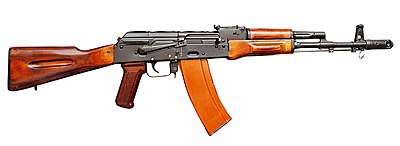
"The AK-74 assault rifle was a Soviet answer to the US M16."[79][80][81] The Soviet military realized that the M16 had better range and accuracy over the AKM, and that its lighter cartridge allows soldiers to carry more ammunition. Therefore, in 1967, the USSR issued an official requirement to replace the AKM and the 7.62×39mm cartridge.[82] They soon began to develop the AK-74 and the 5.45×39mm cartridge.[60][83][84] AK-74 production began in 1974,[85] and it was unveiled in 1977, when it was carried by Soviet parachute troops during the annual Red Square parade.[86] It would soon replace the AKM and become the standard Soviet infantry rifle.[86] In 1979, the AK-74 saw combat for the first time in Afghanistan,[87] where the lethality of the 5.45mm rounds led to the Mujahadeen dubbing them "poison bullets."[88] The adoption of the 5.56mm NATO and the Russian 5.45×39mm cartridges cemented the worldwide trend toward small caliber, high velocity cartridges.[60]
Compact assault rifles
Following the adoption of the M16 rifle, carbine variants were also adopted for close quarters operations. The CAR-15 family of weapons served through the Vietnam War. However, these Compact assault rifles had design issues, as "the barrel length was halved" to 10 inches which "upset the ballistics", reducing its range and accuracy and leading "to considerable muzzle flash and blast, so that a large flash suppressor had to be fitted".[89] "Nevertheless, as a short-range weapon it is quite adequate and thus, [despite] its caliber, [the Colt Commando] is classed as a submachine gun."[89] Other compact assault rifles, such as the HK53, AKS-74U and the Daewoo K1, have been made and they have also been called submachine guns.[90]
Bullpups
In 1977, Austria introduced the 5.56×45mm Steyr AUG bullpup rifle, often cited as the first successful bullpup rifle, finding service with the armed forces of over twenty countries. It was highly advanced for the 1970s, combining in the same weapon the bullpup configuration, a polymer housing, dual vertical grips, an optical sight as standard, and a modular design. Highly reliable, light, and accurate, the Steyr AUG showed clearly the potential of the bullpup layout. In 1978, France introduced the 5.56×45mm FAMAS bullpup rifle. In 1985, the British introduced the 5.56×45mm L85 bullpup rifle. In the late 1990s, Israel introduced the 5.56mm NATO Tavor TAR-21. In 1997, China's People's Liberation Army's adopted QBZ-95 in the new 5.8×42mm cartridge, which they claim is superior to the both 5.56×45mm and the 5.45×39mm. By the turn of the century, the bullpup assault rifle design had achieved worldwide acceptance.
Heckler & Koch G36

The Heckler & Koch G36 is a 5.56×45mm assault rifle, designed in the early 1990s by Heckler & Koch in Germany as a replacement for the heavier 7.62mm G3 battle rifle.[91] It was accepted into service with the Bundeswehr in 1997, replacing the G3.[92] The G36 is gas-operated and feeds from a 30-round detachable box magazine or 100-round C-Mag drum magazine.[91] The G36 was made with the extensive use of lightweight, corrosion-resistant synthetic materials in its design; the receiver housing, stock, trigger group (including the fire control selector and firing mechanism parts), magazine well, handguard and carry handle are all made of a carbon fiber-reinforced polyamide. The receiver has an integrated steel barrel trunnion (with locking recesses) and a nylon 66 steel reinforced receiver.[93] The standard German Army versions of the G36 are equipped with unique a ZF 3×4° dual optical sight that combines a 3× magnified telescopic sight and an unmagnified reflex sight mounted on top of the telescopic sight.[92] Widely distributed, it has been adopted by over 40 countries and prompted other nations to develop similar composite designs, such as the FX-05 Xiuhcoatl.
Distinction from assault weapons
The term "assault rifle" is sometimes conflated with the term "assault weapon". According to the Associated Press Stylebook, the media should differentiate between "assault rifles", which are capable of fully automatic firing, and "assault weapons", which are semiautomatic and "not synonymous with assault rifle".[94] In the U.S., civilian ownership of machine guns (and assault rifles) has been tightly regulated since 1934 under the National Firearms Act and since 1986 under the Firearm Owners Protection Act.[95]
Citations
- ""Assault rifle." Encyclopædia Britannica. 2010. Encyclopædia Britannica Online. 3 July 2010". Britannica.com. Archived from the original on 24 November 2012. Retrieved 2012-08-26.
- C. Taylor The Fighting Rifle: A Complete Study of the Rifle in Combat, ISBN 0-87947-308-8
- F.A. Moyer Special Forces Foreign Weapons Handbook, ISBN 0-87364-009-8
- R.J. Scroggie, F.A. Moyer Special Forces Combat Firing Techniques, ISBN 0-87364-010-1
- Musgave, Daniel D., and Thomas B. Nelson, The World's Assault Rifles, vol. II, The Goetz Company, Washington, D.C. (1967): 1
- Firearms: The Life Story of a Technology. by Roger Pauly. Greenwood Publishing Group. 2004. page 145 & 146
- Jane's Guns Recognition Guide, Ian Hogg & Terry Gander, HarperCollins Publisher, 2005, p.287 Sturmgewehr 44 "This is the father of all assault rifles, developed in Germany in 1941–42 an using a new short cartridge. Originally known as the MP 43 (Machine Pistol) for Nazi political reasons, it was renamed the "Sturmgewehr 44" after its successful introduction into battle on the Eastern Front. It introduced the concept of using a short cartridge with limited range in order to permit controllable automatic fire and a compact weapon, and because experience showed that most rifle fire was conducted at ranges under 400 metres (1,300 ft). After the war it was examined and dissected by almost every major gunmaking nation and led, in one way and another, to the present-day 5.56mm assault rifles."
- https://www.theatlantic.com/technology/archive/2016/06/a-brief-history-of-the-assault-rifle/489428/ Archived 2017-03-30 at the Wayback Machine The Atlantic. A Brief History of the Assault Rifle. The gun’s name may have been coined by Adolf Hitler. by MICHAEL SHURKIN. JUN 30, 2016
- "Machine Carbine Promoted: MP43 Is Now Assault Rifle StG44, WWII Tactical and Technical Trends, No. 57, April 1945". Lone Sentry. 2007-05-10. Archived from the original on 2012-09-21. Retrieved 2012-08-23.
- Musgave, Daniel D., and Thomas B. Nelson, The World's Assault Rifles, vol. II, The Goetz Company, Washington, D.C. (1967)
- Myatt, Major Frederic, Modern Small Arms, Crescent Books, New York (1978): 169
- Hogg, Ivan, and John Weeks, Military Small Arms of the 20th Century, third ed., Hippocrene Books, New York (1977): 159
- Chris Bishop, The Encyclopedia of Weapons of World War II, Sterling Publishing Company, Inc., 2002, p. 218
- Military Small Arms of the 20th Century, 7th Edition, Ian V. Hogg, page 243
- Rottman, Gordon. The AK-47: Kalashnikov-series assault rifles. Osprey Publishing. p. 9. ISBN 978-1-84908-835-0.
- "US Army intelligence document FSTC-CW-07-03-70, November 1970". Gunfax.com. Archived from the original on 2012-08-29. Retrieved 2012-08-26.
- Jane's Gun Recognition Guide. Ian Hogg & Terry Gander. HarperCollins Publishers. 2005. page 330
- http://pogoarchives.org/labyrinth/09/02.pdf Archived 2015-09-06 at the Wayback Machine M16 Rifle Case Study. Prepared for the Presidents Blue Ribbon Defense Panel. March 16, 1970. By Richard R. Hallock, Colonel U.S. Army (Retired)
- Military Small Arms Of The 20th Century, 7th Edition, 2000 by Ian V. Hogg & John S. Weeks, p.243
- Major Thomas P. Ehrhart Increasing Small Arms Lethality in Afghanistan: Taking Back the Infantry Half-Kilometer Archived 2013-07-19 at the Wayback Machine. US Army. 2009
- http://pogoarchives.org/labyrinth/09/02.pdf Archived 2015-09-06 at the Wayback Machine M16 Rifle Case Study. Prepared for the President's Blue Ribbon Defense Panel. March 16, 1970. By Richard R. Hallock, Colonel U.S. Army (Retired)
- Military Small Arms of the 20th Century. 7th Edition. Ian V. Hogg & John S. Weeks. Krause Publications. 2000. page 242–243
- Weapon Of Mass Destruction Archived 2011-09-27 at the Wayback Machine. Washingtonpost.com. Retrieved on 2011-11-19.
- "AK-47 Inventor Doesn't Lose Sleep Over Havoc Wrought With His Invention". USA: FoxNews.com. 6 July 2007. OCLC 36334372. Archived from the original on 3 June 2010. Retrieved 3 April 2010.
It was before he started designing the gun that he slept badly, worried about the superior weapons that Nazi soldiers were using with grisly effectiveness against the Red Army in World War II. He saw them at close range himself while fighting on the front lines. While hospitalized with wounds after a Nazi shell hit his tank in the 1941 battle of Bryansk, Kalashnikov decided to design an automatic rifle combining the best features of the American M1 and the German StG44. "Blame the Nazi Germans for making me become a gun designer," said Kalashnikov, frail but sharp at age 87. "I always wanted to construct agriculture machinery.
- ""Born in November 1919—one of 18 children, of whom only six survived—Mikhail Kalashnikov was a Soviet T-38 tank commander in 1941, wounded in the shoulder and back when a German shell smashed part of the tank's armor into his body. "I was in the hospital, and a soldier in the bed beside me asked: 'Why do our soldiers have only one rifle for two or three of our men, when the Germans have automatics?' So I designed one. I was a soldier, and I created a machine gun for a soldier. It was called an Avtomat Kalashnikova, the automatic weapon of Kalashnikov—AK—and it carried the date of its first manufacture, 1947." An interview with Mikhail Kalashnikov, Robert Fisk, The Independent (centrist), London, England. April 22, 2001". Archived from the original on October 1, 2016. Retrieved July 8, 2016.
- http://armedforcesmuseum.com/ak-47-assault-rifle/ Archived 2013-06-16 at Archive.today | Armed Forces History Museum, AK-47 assault rifle
- Chapter 1. Symbol of violence, war and culture Archived June 16, 2012, at the Wayback Machine. oneworld-publications.com
- http://pogoarchives.org/labyrinth/09/02.pdf Archived 2015-09-06 at the Wayback Machine M16 Rifle Case Study. Prepared for the President's Blue Ribbon Defense Panel. March 16, 1970. By Richard R. Hallock, Colonel U.S. Army (Retired) "Used in quantity against the Soviets at Stalingrad, the German Sturmgewehr made a deep impression on the Russians. They copied the ballistics of the cartridge while improving the configuration and improving the weapon. They standardized the weapon in 1947 as the AK-47 rifle."
- http://english.pravda.ru/history/02-08-2003/3461-kalashnikov-0/ Archived 2015-10-15 at the Wayback Machine "The history of the world-known gun started on July 15th, 1943, when a captured complex—an MP-43 gun and a cartridge—were demonstrated at a meeting of the arms committee. Chief designer Nikolay Elizarov and chief engineer Pavel Ryazanov created the Soviet "interim cartridge " within a very short period of time. The technological support was provided by Boris Syomin. After that, scientists started working on a new fire arms system for that cartridge." The History of Kalashnikov Gun. Pravda. 02.08.2003
- ""Germany invaded the Soviet Union in June 1941. Kalashnikov, by then a sergeant, was injured within months when a shell stopped his T-34 tank and sent shrapnel through his shoulder. As Soviet history tells it, while Sgt. Kalashnikov recuperated, he began tinkering with infantry weapons, eventually setting his mind on designing a lightweight automatic assault rifle that would expel the better-armed Nazis from Russian soil. Soviet infantry fought World War II with two basic small arms: one was the badly outdated Mosin–Nagant Model 1891 bolt-action rifle. The other was the PPSh series of submachine guns, reliable arms that were effective but only at short range. Something better was needed, and that something was in the hands of the Nazi Wehrmacht. It was called the MP44 Sturmgewehr (assault rifle), and it could fire in full or semiautomatic mode. Chambered for a revolutionary new cartridge, a short 7.92mm round that was less powerful than a full-size rifle cartridge, yet far more powerful than the pistol cartridges for which submachine guns were chambered, the Sturmgewehr made a deep impression on the Soviets who faced it." The Father of 100 Million Rifles Mikhail Kalashnikov was a poor Russian farm boy who happened to be a mechanical genius, and for better or for worse, the rifle he designed has changed history. Article by C.J. Chivers. Uploaded on February 28, 2006". Archived from the original on August 15, 2016. Retrieved July 8, 2016.
- History of AK-47 Gun – The Gun Book Review Archived 2014-08-03 at the Wayback Machine. Popular Mechanics (2010-10-12). Retrieved on 2012-02-09.
- http://www.virginia1774.org/DIA-ST-HB-07-03-74.pdf Archived 2016-03-04 at the Wayback Machine Small Arms Identification and Operations Guide-Eurasain Communist Countries. by Harold E. Johnson. September 1973. U.S. Army Foreign Science and Technology Center of the U.S. Army Materiel Command.
- https://www.theguardian.com/world/2003/oct/10/russia.nickpatonwalsh Archived 2017-05-10 at the Wayback Machine Interview with AK-47 rifle inventor Mikhail Kalashnikov. 'I sleep soundly' Shamed by his parents' exile, he was determined to do his bit for the Soviet cause. And so Mikhail Kalashnikov invented what was to become the world's most prolific killing machine. Nick Paton Walsh tracks down the 83-year-old at his tranquil lakeside. by Nick Paton Walsh. The Guardian, Thursday 9 October 2003
- "Interview with AK-47 rifle inventor Mikhail Kalashnikov. Russia celebrates Mikhail Kalashnikov's 90th birthday – the designer who armed the world. This online supplement is produced and published by Rossiyskaya Gazeta (Russia), which takes sole responsibility for the content". Archived from the original on 2015-12-09. Retrieved 2018-04-06.
- Killicoat, Phillip (April 2007). "Weaponomics: The Global Market for Assault Rifles" (PDF). World Bank Policy Research Working Paper 4202 (Post-Conflict Transitions Working Paper No. 10). Oxford University. Archived (PDF) from the original on 12 January 2012. Retrieved 3 April 2010.CS1 maint: ref=harv (link)
- Rose, Alexander (2009). American Rifle: A Biography. Delta. pp. 403–405. ISBN 978-0-553-38438-3.
- "Machine Carbine Promoted, M.P. 43 Is Now "Assault Rifle 44", Tactical and Technical Trends, No. 57, April 1945, U.S. Military Intelligence Service, U.S. War Department publication". Archived from the original on 2008-01-16. Retrieved 2008-04-19.
- The M16. By Gordon Rottman. Osprey Publishing, 2011. page 6
- http://www.nramuseum.com/media/940585/m14.pdf Archived 2013-12-04 at the Wayback Machine |CUT DOWN in its Youth, Arguably Americas Best Service Rifle, the M14 Never Had the Chance to Prove Itself. By Philip Schreier, SSUSA, September 2001, p 24-29 & 46
- Gordon Rottman (2011). The M16. Osprey Publishing. p. 6. ISBN 978-1-84908-690-5. Archived from the original on 2016-01-24. Retrieved 2015-10-29.
- Leroy Thompson (2011). The M1 Carbine. Osprey Publishing. p. 35. ISBN 978-1-84908-907-4.
- Arms of the Chosin Few Archived 2013-12-05 at the Wayback Machine. Americanrifleman.org. Retrieved on 2011-11-23.
- Donald L. Hall An effectiveness study of the infantry rifle Archived 2015-09-24 at the Wayback Machine (PDF). Report No. 593. Ballistic Research Laboratories. Maryland. March 1952 (released March 29, 1973)
- Fanaticism And Conflict In The Modern Age, by Matthew Hughes & Gaynor Johnson, Frank Cass & Co, 2005
- "South to the Naktong – North to the Yalu". History.army.mil. Archived from the original on 2013-11-02. Retrieved 2012-08-23.
- HyperWar: The Big 'L'-American Logistics in World War II Archived 2013-12-03 at the Wayback Machine. Ibiblio.org. Retrieved on 2011-12-24.
- The Logistics of Invasion Archived 2015-06-22 at the Wayback Machine. Almc.army.mil. Retrieved on 2011-11-23.
- Col. E. H. Harrison (NRA Technical Staff) New Service Rifle Archived 2015-11-07 at the Wayback Machine (PDF). June 1957
- Anthony G Williams Assault Rifles And Their Ammunition: History and Prospects Archived June 2, 2014, at the Wayback Machine. Quarry.nildram.co.uk (revised 3 February 2012). Retrieved on 2011-11-23.
- http://www.smallarmsreview.com/display.article.cfm?idarticles=2434 Archived 2016-04-22 at the Wayback Machine Small Arms Review, M14 VS. M16 IN VIETNAM, By Robert Bruce
- Jane's International Defence Review. Volume 36. Jane's Information Group, 2003. Page 43. "The M14 is basically an improved M1 with a modified gas system and detachable 20-round magazine."
- M14 7.62mm Rifle Archived 2014-11-09 at the Wayback Machine. Globalsecurity.org (1945-09-20). Retrieved on 2011-11-23.
- Jane's Guns Recognition Guide. Ian Hogg & Terry Gander. HarperCollins Publishers. 2005 page 275
- Bishop, Chris. Guns in Combat. Chartwell Books, Inc. (1998). ISBN 0-7858-0844-2.
- Woźniak, Ryszard: Encyklopedia najnowszej broni palnej—tom 2 G-Ł, page 7. Bellona, 2001.
- Jane's Guns Recognition Guide. Ian Hogg & Terry Gander. HarperCollins Publishers. 2005 page 288
- Lee Emerson M14 Rifle History and Development Archived 2017-12-15 at the Wayback Machine. October 10, 2006
- Green Beret in Vietnam: 1957–73. Gordon Rottman. Osprey Publishing, 2002. p. 41
- Hutton, Robert (ed.), The .223, Guns & Ammo Annual Edition, 1971.
- Danford Allan Kern The influence of organizational culture on the acquisition of the m16 rifle Archived 2013-11-05 at the Wayback Machine. m-14parts.com. A thesis presented to the Faculty of the US Army Command and General Staff College in partial fulfillment of the requirements for the degree MASTER OF MILITARY ART AND SCIENCE, Military History. Fort Leavenworth, Kansas 2006
- Peter G. Kokalis Retro AR-15 Archived 2013-10-29 at the Wayback Machine. nodakspud.com
- Ezell, Edward Clinton (1983). Small Arms of the World. New York: Stackpole Books. pp. 46–47. ISBN 978-0-88029-601-4.
- https://looserounds.com/2015/01/30/the-m14-not-much-for-fighting-a-case-against-the-m14-legend/ Archived 2016-08-27 at the Wayback Machine The M14 not much for fighting (A case against the M14 legend)
- Report of the M16 rifle review panel Archived 2015-09-24 at the Wayback Machine. Department of the Army. dtic.mil. 1 June 1968
- GX. The Guard Experience. The Pride of the Guard. by Major Darrin Haas. Volume 10. Issue 3. 2013. Page 67. "Nicknamed a 'Mattel toy' because of its small caliber and lightweight design, the M16 became the standard service rifle for U.S. forces in vietnam in 1967. The weapon was much lighter compared to the M14 it replaced, ultimately allowing Soldiers to carry more ammunition. The air-cooled, gas-operated, magazine-fed assault rifle was made of steel, aluminum alloy and composite plastics, truly cutting-edge for the time. Designed with full and semi-automatic capabilities, the weapon initially did not respond well to wet and dirty conditions, sometimes even jamming in combat. After a few minor modifications, the weapon gained in popularity among troops on the battlefield. Still in service today, the M16 is being phased out by the M4 carbine.
- Office of the Deputy Chief of Staff for Research, Development, Acquisition (1 June 1968), Report of the M16 Review Panel (PDF), M16 Surveys in the Republic of Vietnam, Washington DC: Department of the Army, archived (PDF) from the original on 4 March 2016, retrieved 8 July 2016
- Small Arms. By Martin J. Dougherty. The Rosen Publishing Group, Dec 15, 2012. page 26
- Per G. Arvidsson Weapons & Sensors Archived 2012-09-04 at the Wayback Machine. NATO Army Armaments Group
- http://www.vsms.org/Forum/Seite_69_tactical_stuff/120500_Sights_Accessories_Compendium.pdf Archived 2013-12-03 at the Wayback Machine Compendium Special Operations by Armada. Assault Rifles. by Paolo Valpolini 2/2012 "Among western armies the M4 with its 356-mm-long barrel remains the benchmark type, although reports from the field have shown some criticism regarding its reliability in sand and dusty environments due to the direct impingement or 'gas-tube' system that tends to bring carbon blow-back into the chamber, while hot gases used to cycle the weapon generate heat problems."
- ""Colt literature notes that the fourth generation of the M16 "still represents the world standard by which all other weapons of this class are judged. Its combat-proven performance is verified by the fact that over eight million M16 weapon systems have been produced and placed in military service throughout the world." Soldier Armed. M16A4 Rifle. By Scott R. Gourley. Army Magazine. July 2008 page 75" (PDF). Archived (PDF) from the original on 2015-09-23. Retrieved 2016-07-08.
- Assault Rifles and Their Ammunition: History and Prospects by Anthony G. Williams Archived 2014-06-02 at the Wayback Machine
- "An Improved Battlesight Zero for the M4 Carbine and M16A2 Rifle". Archived from the original on 2011-10-25. Retrieved 2007-09-11.
- "TM 9-1005-319-10 (2010) – Operator's Manual for Rifle, 5.56 MM, M16A2/M16A3/M4 (Battlesight Zero pages 48–55)" (PDF). Archived (PDF) from the original on 2014-02-08. Retrieved 2014-06-03.
- Military Small Arms of the 20th Century. 7th Edition. by Ian V. Hogg & John S. Weeks. Krause Publications 2000. pages 235, 258, 274, 278
- LEGION Ltd. – the producer of high quality firearms with period artistic treatment (threading, engraving, incrustation) and improved finishing. izhmash.ru
- http://www.militaryfactory.com/smallarms/detail.asp?smallarms_id=256 Archived 2014-07-01 at the Wayback Machine |The Kalashnikov AK-101 is an export assault rifle in operational service withat least nine nations worldwide
- Military Small Arms of the 20th Century. 7th Edition. by Ian V. Hogg & John S. Weeks. Krause Publications 2000. pages 233, 257, 266, 296
- Arsenal AR-M1 5.56mm assault rifle Archived June 18, 2014, at the Wayback Machine
- "AK-74 Assault Rifle - Military-Today.com". Archived from the original on 2015-01-09. Retrieved 2016-07-08.
- "Tactical Life. Bulgarian AK-74 5.45x39mm. The AK-74 signified the Soviets' response to the West's M16. By Michael Humphreis October 15, 2013". Archived from the original on August 1, 2016. Retrieved July 17, 2016.
- Gun Digest Shooter's Guide to AKs. by Marco Vorobiev. F+W Media, Inc. Jun 15, 2016. page 107
- https://web.archive.org/web/20110629045720/http://www.izhmash.ru/eng/arc/021205.shtml "AK-74 – Kalashnikov assault rifle, caliber 5.45 mm. In 1967, pursuant to the Resolution of the CPSU Central Committee and the USSR Council of Ministers, a competition was organized to design an assault rifle fit to use the new 5.45×39mm cartridge. The AK-74 was designed by А. D. Kryakushin's group under the designer supervision of M. T. Kalashnikov. Based on the competition results, this assault rifle was included in the inventory in 1974 as part of the 5.45×39mm small arms complex. The cartridge used in the AK-74 weighs 1.5 times less as compared with the 7.62-mm cartridge. The soldier can carry 1.5 times more cartridges without increasing the weight of the portable reserve ammunition. In addition, the bullet speed of the 5.45-mm caliber is higher."
- Military Small Arms of the 20th Century. 7th Edition. by Ian V. Hogg & John S. Weeks. Krause Publications 2000. page 271
- Dockery, Kevin (2007). Future Weapons. p. 70. ISBN 0-425-21750-7.
- https://web.archive.org/web/20110629045720/http://www.izhmash.ru/eng/arc/021205.shtml "AK-74 – Kalashnikov assault rifle, caliber 5.45 mm. In 1967, pursuant to the Resolution of the CPSU Central Committee and the USSR Council of Ministers, a competition was organized to design an assault rifle fit to use the new 5.45-mm cartridge. The AK-74 was designed by А. D. Kryakushin's group under the designer supervision of M. T. Kalashnikov. Based on the competition results, this assault rifle was included in the inventory in 1974 as part of the 5.45-mm small arms complex. The cartridge used in the AK-74 weighs 1.5 times less as compared with the 7.62-mm cartridge. The soldier can carry 1.5 times more cartridges without increasing the weight of the portable reserve ammunition. In addition, the bullet speed of the 5.45-mm caliber is higher."
- Military Small Arms Of The 20th Century, 7th Edition, 2000 by Ian V. Hogg & John S. Weeks, p.271
- The AK-47: Kalashnikov-Series Assault Rifles. by Gordon L Rottman. Osprey Publishing, Jan 1, 2012. page 32
- Mark Urban, War in Afghanistan, p. 133, Springer, 27 Jul 2016
- Military Small Arms Of The 20th Century, 7th Edition, 2000 by Ian V. Hogg & John S. Weeks, p. 166
- Military Small Arms of the 20th Century. 7th Edition. by Ian V. Hogg & John S. Weeks. Krause Publications. 2000. pages 125 & 166–167.
- "Modern Firearms - HK G36". World.guns.ru. Archived from the original on 2010-09-02. Retrieved 2012-12-15.
- Woźniak, Ryszard. Encyklopedia najnowszej broni palnej – tom 2 G-Ł. Bellona. 2001. pp17-21.
- US5513461A - Light-weight automatic rifle. Google.com. Retrieved 2015-7-15.
- Blake, Aaron (January 17, 2013). "Is It Fair to Call Them 'Assault Weapons'?". The Fix (blog). The Washington Post. Archived from the original on February 11, 2015. Retrieved August 9, 2016.
- Koerner, Brendan (September 16, 2004). "What Is an Assault Weapon? At last, you can get a semiautomatic rifle with a bayonet". Slate. Archived from the original on September 13, 2014. Retrieved January 26, 2013.
References
- Rose, Alexander (2008). American Rifle: A Biography. Bantam Dell Publishing. ISBN 978-0-553-80517-8.
Further reading
- Crawford, S. (2003). Twenty-First Century Small Arms. MBI Publishing Company. ISBN 0-7603-1503-5.
- Cutshaw, C. (2006). Tactical Small Arms of the 21st Century. Gun Digest Books. ISBN 0-87349-914-X.
- Halls, Chris (1974). Guns in Australia. Sydney: Paul Hamlyn. ISBN 0-600-07291-6.
- Lewis, J. (2004). Assault Weapons: An In-Depth Look at the Hottest Weapons Around. Krause Publications. ISBN 0-87349-658-2.
- Popenker, M., et al. (2004). Assault Rifle: The Development of the Modern Military Rifle and Its Ammunition. Wiltshire: The Crowood Press Ltd. ISBN 1-86126-700-2.
- Senich, P. (1987). German Assault Rifle: 1935–1945. Paladin Press. ISBN 0-87364-400-X.
External links
| Wikimedia Commons has media related to Assault rifles. |
| Wikiquote has quotations related to: Assault rifle |


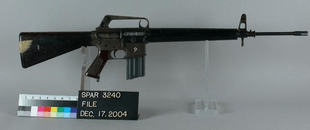

.jpg)
